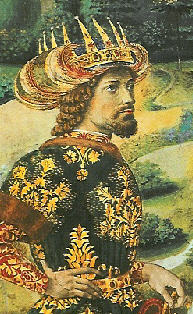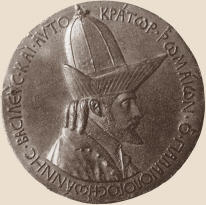John Palaiologos VIII, Emperor
|
About the life of John's father Manuel Palaiologus and the already desperate situation in Constantinople reports the following link: Manuel Palaiologos John Palaiologos, then co-regent to his father in Constantinople, had married Sophia of Montferrat in the year 1421. Sophia of Montferrat had been earlier (1406 - 1411) the first wife of Filippo Maria Visconti, a never consumated political arrangement with a very young bride, which lost its never really existent reality, when in 1411 the condottiero Ficino Cane took charge of Pisa and the young duke's brother. The prospects of Filippo Maria Visconti were rather bad then. Filippo was released by Ficino's death one year later, but had to marry Beatrice de Tender, the 20-years-older widow of Ficino Cane to get enough money and influence to reestablish the dukedom after his brother's assassination, which happened nearly parallel to Ficino's death in the same month, May 1412. Time passed. Filippo became powerful again and in 1418 he accused Beatrice de Tender cause of adultery. Beatrice ended beheaded. In Constantinople the pressure of the Osmans urged the family of the Emperor to arrange with allies in the West, in Italy. John's brother married a Malatesta daughter, John himself got Sofia, ex-wife from Filippo Maria Visconti. At the same time (1421) Filippo Maria Visconti got through successful operations of his condottiere Carmagnola the rulership in Genua. As Genua was the great concurrent of Venice on the Mediterrean sea, Filippo Maria became by this an influential factor also in the region of Constantinople. In 1422 the Osmans reopened the hostilities and Constantinople in its difficulties decided to send John in research for militarical help to Italy. John left in adventurous manner Constantinople in November 1423, but soon after his departure his brother was able to arrange a momentary peace with Sultan Murad (22th February 1424). John reached Italy, first under the condition, that he didn't knew about the peace treaty in his home country. He visited various courts in Italy, under them also the court in Milan and Filippo Maria Visconti. His stay endured not too long, in June 1424 he is already reported to have been at a visit of Emperor Sigismondo in Hungary. Considering the long travel distances and the fact, that he visited various courts in Italy, he couldn't have spend too much time in Milan. At begin of November 1424 he is back in Constantinople with the advice of Emperor Sigismondo, that his chances of securing aid from western Christendom would be better if he and his people would swear obedience to the Pope in Rome. This leads more than a decade later to the council of Ferrara/Florence in the years 1438/1439, a theme which is concentrated in our article Ferrara 1441. Nonetheless the visit could have made a strong impression on Filippo Maria, who - as far we know it - never left Milanese territory and who didn't have much opportunity in his life to meet people of the same or a similar high rank than himself (we know of the high guests John Palaiologos and of Alfonso of Aragon; when Emperor Sigismondo visted Milano in 1431, Filippo Maria avoided any personal contact). The condition, that he did meet the husband of his earlier wife from an "unreal marriage" might have raised additional curiosity on his side. The interest in Greek matters was vivid in Milano already in 1400 - 1403, when the Greek teacher chrysoloras spend some time in Pavia and the Greek Emperor of that time (Manuel) also made a journey through Europe to gather help for his problems in Constantinople (compare the Decembrio biography). Filippo Maria was young then (8 - 11 years old), but he might have gotten some impressions there. It is reported, that Filippo Maria in 1423/1424 ordered the decoration of rooms for the expected visit of the Emperor in the castle of Pavia (actually this means, that Filippo showed greater interest), the painter is said to have been Pisanello, who realised some frescoes with "hunting scenes". "Hunting scenes" were loved by cardmakers of the time, we know that by comtemporary German decks. The motif "Apollo hunts Daphne", realised in the Michelino deck, might - with some goodwill - be counted as a "hunting motif" . The paintings of Pisanello are lost, so a question, if Pisanello's prepared something, which reappeared in Michelino's deck, stays unanswered. Pisanello and Michelino are suspected to have known each other from earlier times in Venice, so a cooperative work wouldn't surprize. Pisanello, who was present in Ferrara in 1438, made then a medal with the portrait of John Palaiologos (see at the left) - it's assumed, that this was the first of many medals, which were manufactured by Pisanello and which gave us the portraits of many important persons of the time (it's unclear, but possible, that John was personally acquainted to Pisanello already since 1424). We think, that this short visit of the Greek emperor left an impulse on Filippo Maria Visconti, which finally did lead to the decision to give the Trionfi deck the content of old Greek gods. The painter became Michelino and Martiano da Tortona was commissioned to write an accompanying manuscript. It's only a theory, of course, but we think, that the Greek gods were not a common motif in 1424 in Italy, so it seems logical to ask for the curious reason of their early appearance. The marriage between John and Sophia of Montferrat didn't take a good run - perhaps cause of missing children. It was divorced in 1426 and Sophia returned to Italy. A twice divorced woman - a rarity at this time. |
  |